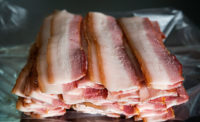Demand for meat packaging in the United States stands at $5.1 billion and will grow steadily through 2021, predicts a report from The Freedonia Group, in Cleveland, Ohio. The market study, Meat Packaging Market in the U.S., Industry Study with Forecast for 2021, covers fresh, frozen, processed and ready-to-eat products.
It attributes market growth to continued implementation of case-ready packaging in the fresh-meat sector and a greater need for the high-performance packaging required for this format. In addition, shrinking household sizes are driving meat processors to reduce package weights and increase the number of convenient, single-serving offerings. The shift to smaller packs is expected to boost volume demands for packaging materials overall.
The report notes traditional packaging formats – corrugated boxes, film, bags and trays –continue to dominate. Projections call for boxes to experience continued growth due in part to greater use of retail-ready packaging in the shipment and display of processed foods. Although trays and bags will see some share erosion as tray-less vacuum packaging formats gain popularity with retailers, all films, bags and trays used for packaging fresh meat will benefit from greater demands for extended shelf life and better package performance.
In the frozen and processed meat sectors, niche packaging formats will capture share from other formats and experience the fastest growth. Pouches will register continued gains for frozen meat products while plastic containers score for fresh prepared entrees and premium processed meat offerings.
Markets associated with fresh foods will experience the strongest growth through 2021 as consumers favor minimally processed foods and brands with “clean” labels. The fresh and frozen meat sector will see gains as home cooking is viewed by many as the best way to follow dietary guidelines.
One technology that dovetails with consumer interest in clean labels, high-pressure processing (HPP), is likely to experience wider adoption and spur greater use of flexible packaging. Already used for seafood, HPP inactivates spoilage bacteria and pathogens, enhancing food safety, eliminating the need for preservatives, extending shelf life and reducing food waste. Since the process does not use heat, product taste, fibers and textures are unaffected.
Indicative of the growing use of HPP technology, HPP service providers are expanding capacity. Another indicator boding well for rising usage of HPP is the formation of a trade association, the Cold Pressure Council. It was convened early in 2017 by PMMI, The Association for Packaging and Processing Technologies, in Reston, Va. Its mission is “to lead, facilitate and promote industry standardization, user education and consumer awareness of HPP.” One of its first efforts, the 2017 HPP Summit, was to be held Oct. 2-4, 2017, at the Atlanta Marriott Buckhead Hotel and Conference Center (after press time for this issue).
Convenience remains a driving force for meat, poultry and seafood packaging. With busy lifestyles leaving little time to dine as a family, cook or shop, consumer demand is rising for protein-based snacks, prepared entrees and meals, and home delivery. Beneficiaries of this growth include flexible packaging, retort pouches, standup pouches and temperature-controlled packaging.
One example of a recently launched convenience product is a heat-and-eat hot dog in a microwaveable pouch, which is merchandised in a secondary carton. Den’s Natural and Gourmet and Den’s Kosher all-in-one, heat-and-eat hot dog sandwiches from Den’s Hot Dogs, in Brooklyn, N.Y., come with choice of condiments. Designed to be ready to eat after less than a minute in the microwave and a minute of standing time, the single-serving sandwiches are said to be a more sanitary and less wasteful alternative to traditional C-store offerings and dogs prepared on roller grillers.
Sustainability is another driving force influencing meat, poultry and seafood packaging. Rigid packaging is often selected based on renewable content and/or recyclability. Recycled content has been less available in non-fiber-based formats, but that is changing with the development of polystyrene trays with 25 percent recycled content and the growing availability of polyethylene terephthalate packaging with recycled content.
For flexible packaging, a combination of source reduction and longer shelf life occurs when ultrasonic sealing replaces heat sealing. A savings in packaging material results because ultrasonic seals tend to be about 2 mm, substantially narrower than most heat seals. In addition, packages typically are smaller due to the need for less headspace. Sealing is not affected by product debris in the seal area, reducing the chance of leakers to almost zero and eliminating associated waste. Tighter seal integrity means lower oxygen transmission through the seal area, longer shelf life and less food waste. No warmup time and an on/off process consume less energy than heat sealing. In addition, faster line speeds are possible, especially for heavier packs, because bonds are at full-strength almost as soon as the sealing process concludes. Finally, today’s ultrasonic sealers represent a smaller capital investment and are easier to operate than models from just a few years ago.
On the packaging line, attention is focused on maximizing food safety and higher levels of automation. Quality control equipment ranges from metal detectors to x-ray inspection and leak detection. One online leak detector for modified-atmosphere packaging is designed to test meat, poultry, seafood and prepared foods packs produced on tray sealers and thermoform-fill-seal machines. It non-destructively tests packages online and can achieve 100 percent sampling at speeds up to 120 packages per minute. Hydrogen is used as a tracer gas. An alarm provides an alert if a leak is detected.
Packaging lines are increasingly automated. At the most basic level, automation shifts operators from manual tasks such as case packing, film splicing and machine changeover, eliminating ergonomic issues associated with repetitive motions, boosting output, efficiency and consistency and reducing costs. At the highest level, complex changeovers, which require multiple adjustments of the machine, can be accomplished by calling up a recipe on the operator interface and pushing a button. Today’s operator interfaces also can lead operators through each production step, provide dashboards showing performance in real time and often oversee more than one machine.
Advanced controls can combine motion and safety in one controller and support remote diagnostics, real-time data collection and transmission of data upstream to the enterprise or the Cloud. With the data collected, trends can be identified and analyzed, processes can be optimized and record keeping can be automated.
Finally, simulation software allows machines to be viewed, controlled and demonstrated in a virtual reality environment. As a result setup and operation can be optimized, tested and debugged offline to reduce development and setup time. NP





Report Abusive Comment